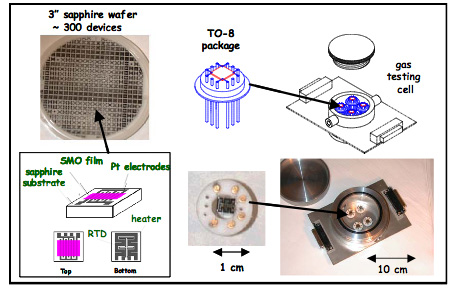The Laboratory for Surface Science & Technology (LASST) at the University of Maine is an interdisciplinary research center with over 25 years experience in the development of novel materials, devices, and sensors for detecting a wide range of environmentally toxic substances, industrial chemicals, and biomedical compounds. Next generation sensors and detectors are being developed for both gas phase and liquid phase detection of chemical and biological species in the environment. The technologies, which emphasize sensitivities in the parts per billion ranges, include semiconducting metal oxide (SMO) gas sensors, piezoelectric acoustic wave liquid sensors, miniaturized infra-red detectors coupled with nanoporous materials, and miniaturized mass spectrometers. Research & development activities focus on functionalized surfaces, thin film materials, sensor design and fabrication, sensor packaging, wireless communication, sensor test and evaluation, and data informatics. Several of the prototype sensor devices developed at LASST have large potential for contributing to environmental monitoring of species that are relevant to assessing climate change.
Chemical Gas Sensors
SMO thin film sensors convert gas adsorption signatures at a reactive surface into an electrical conductivity change within film. The critical component that provides the sensitivity and selectivity is the appropriately functionalized sensor surface. Several types of ultra-thin oxide films with a variety of surface catalysts have been developed, packaged into test cells, and evaluated versus target gas concentration and interferent gases using a multichannel gas delivery system. Efforts are underway to make these sensors more field-portable.

Chemical gas sensor devices fabricated with a semiconducting metal oxide (SMO) film on a sapphire wafer. The double sided device is suspended by wire bonds in a TO-8 package that is plugged into a gas testing cell. These devices have been used to measure NOx, H2S, Cl2, H2, HCl, CO, alcohols, and organophosphonates at the low parts per billion range.
Chem/Bio Liquid Phase Sensors
Piezoelectric acoustic wave sensors, containing selective surfaces for detection of toxic chemicals and pathogens, can very sensitively detect changes of high frequency propagating waves on the sensor surface as it interacts with the environment. These sensors operate in a liquid environment and can measure toxic chemicals, pesticides, bacteria, and viruses at parts per billion levels. R&D activities involve surface functionalization, automated sampling, and miniaturized electronics needed for routine deployment in environmental applications. Integrated sensor systems are being developed to include fluidic, mechanical, optical, electrical and biochemical components.
